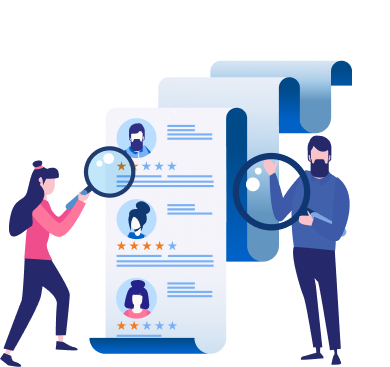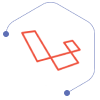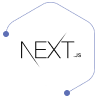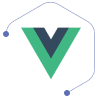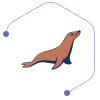The concept of multi-platform development is around creating software that performs effectively in more than one digital environment. Typically, this feature is pursued by offering software for more than one proprietary operating system, such as usage on both Microsoft and Apple platforms.
Cross-platform programming has grown in popularity for a reason. It enables custom software application development service providers to collaborate on a single codebase that can operate on several platforms. This reduces the number of repetitive jobs in the development cycle and speeds up the whole process.
As a result, cross platform development is cost-effective and aids in reaching people across all platforms. Compiling distinct versions of the same software for various operating systems is one of the primary methodologies for multi-platform development.
There is a constraint in that multi-platform development might reduce the efficiency of a program. For example, it may necessitate duplicate file storage folders or procedures to support many systems. However, developers have recognized that this is a small price to pay for all of the advantages that multi-platform programming provides.
There are several multiplatform mobile application development applications available. These are known as development tools, and they serve as a vital pillar of the tech sector in the creation and development of mobile applications. Kotlin and React Native are the most popular cross platform development tools for creating mobile applications. Online sites are simply accessible to the Kotlin application development services and react native app development services.
Let us first understand the concept of what React Native and kotlin are to move further on the above-mentioned title:
React Native
What is React Native?
React Native is a JavaScript-based framework used mainly for building native-like Android and iOS applications. It has quickly become the favorite choice for multi-platform app development in the past few years. React Native’s codebase is used for web apps and desktops.
Features of React Native
There is a reason why many multi-platform app developers prefer using React Native – it is easy to use and highly scalable.
Hot Reloading
This is one of the chief features of React Native. This feature speeds up the development time, which lets your app reload automatically. It even helps you to visualize the change immediately. Therefore, it is a time-saving feature that improves concentration and productivity.
Better Performance
React Native can compile your app into native apps, which seems identical to apps created using native tools.
Native UI Components
This cross platform development feature helps you create views using the React Native UI Components, further compiled into platform-specific UI components. The core advantage of this feature is it saves lots of time.
Reliability
As Facebook develops cross-platform, therefore it is preferred by most of the top mobile apps, for instance, Facebook, Instagram, and Skype.
Free Source
React Native is open-source which is completely free to use. Web developers mostly prefer this cross-platform for developing mobile apps.
Builds Faster
The major advantage of React Native is its shorter development time. When you find the desired components in React Native, it makes it easier to build faster. You can benefit from just a simple step: hire react native developers and get your app to market in no time.
Use cases of React Native
React Native is used for creating apps requiring heavy lifting. It is not suitable for resource-intensive apps. React Native was designed by Facebook to replace HTML5 to deliver exceptional mobile application experiences. Since then become a pro at silently working in the background of client devices and making JavaScript a feasible language for developers.
Real-life examples of React Native
Walmart, Bloomberg, Gyroscope, UberEats, Instagram, and Facebook Ads Manager are some famous brands using the framework for their React Native app development ventures.
Kotlin
What is Kotlin?
Kotlin was traditionally known as a programming language. However, in 2020, JetBrains rolled out free and open-source Kotlin Multiplatform, which specifically allows developers to use a single codebase for building apps for Android and iOS.
Kotlin is a statically-typed framework that generates a codebase that can run on the Java virtual machine. Its name originates from Kotlin Island, near St. Petersburg, Russia. Even though the language’s syntax is not compatible with Java, Kotlin can interoperate with it.
Features of Kotlin
Kotlin is considered a practical option for multi-platform app platforms. Android has a proper setup for translating Java codes into Kotlin. Kotlin codebases can work on the Java Virtual Machine. Here is the top feature.
Reliability Feature
As earlier, it has been discussed that Kotlin is a mature programming language; it went through different stages of testing before the final release. Hence, it is considered a polished language with great reliability features.
Compatibility with Existing Code
Kotlin works well with the JAVA script by including all necessary tools and frameworks, which provides a rich ecosystem.
Easy to Pick Up
The syntax of Kotlin is quite similar to other languages such as JAVA and Swift, which helps the developer to understand it more easily.
Uses single codebase
This cross-platform development feature, helps you use a single codebase that helps share logic and libraries below the user interface layer, enabling users to interact directly with iOS or Android.
Utilizes Native UI
In Kotlin Multiplatform, you can experience a native user interface. This lets you utilize native user interface elements, making you feel natively developing the application.
Modulated Integration
One of the biggest advantages of using Kotlin multiplatform is an SDK rather than a framework. It easily allows the existing team to add a module or migrate it without commitment.
Use cases of Kotlin
Kotlin is predominantly used for Android app development – with Google’s official support. It comes in handy in building many project management tools, eCommerce sites, and social media platforms.
Real-life examples of Kotlin
Pinterest, Trello, Corda, Airbnb, Basecamp, and Zomato are some popular brands using the framework for their Kotlin app development ventures.
React Native vs. Kotlin: A robust comparison
React native app development services have already risen to the top of the list of the finest cross-platform development tools. On the other hand, the recently released Kotlin Multiplatform fully enables cross-platform development for Android and iOS and includes a slew of current capabilities.
But it’s no wonder that these two frameworks are so distinct. Let us do a thorough comparison:
Performance levels
By allowing developers to construct apps utilizing JavaScript and native modules, React Native provides a native-like experience. React Native is lightning fast and has a native appearance and feel on both iOS and Android.
Kotlin, on the other hand, enables developers to construct platform-specific codebases and exchange business logic built in the programming language with ease. Kotlin-based apps are faster, but not faster than React Native apps.
Development experience
React Native provides ready-to-use components, rapid reloading, and native development capabilities to developers. Experienced developers may simply use JavaScript in addition to native UI to create Android and iOS apps from the same codebase.
Kotlin Multiplatform, on the other hand, enables developers to reuse multi-platform functionality and build platform-specific codebases as needed, making the development cycle faster and easier. Who wouldn’t want that?
Cost and time
You also don’t want to overspend your timeframes or budget while designing apps for various platforms. If money is an issue, React Native is the way to go. It is ideal for creating MVPs and prototypes.
Kotlin, like React Native, is free and allows you to create fast apps with minimal resources. It is appropriate if time is a constraint for you since writing and deploying functioning code on Kotlin requires less time and fewer lines.
Learning curve
Even though it makes use of JavaScript and sophisticated frameworks, React Native has a high learning curve. JavaScript developers will have no trouble creating multi-platform applications using React Native.
Because of the widespread usage and promise of React Native, finding developers with the necessary skill set is simple. On the other hand, because it is completely compatible with Java, Kotlin has a shallow learning curve, and many web developers find it simple to learn and use.
Bottomline
Following a thorough examination of both React Native and kotlin, it is evident that both can successfully and efficiently allow multi-platform development. What you choose, on the other hand, is entirely reliant on what you want to achieve with your project.
Whether you use Kotlin or collaborate with a React Native development company, choosing the right option will help you turn around the product faster and more cost-effectively. You can always come to us with your ideas.
ByteCipher experts are multi-platform development pioneers you can hire and who have worked on a variety of projects over the last decade. Send us a quick letter and we will respond as soon as possible. You will be astounded by our knowledge and experience.


